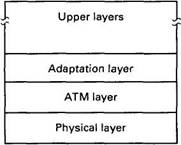Книга: Distributed operating systems
2.2.1. What Is Asynchronous Transfer Mode?
2.2.1. What Is Asynchronous Transfer Mode?
In the late 1980s, the world's telephone companies finally began to realize that there was more to telecommunications than transmitting voice in 4 KHz analog channels. It is true that data networks, such as X.25, existed for years, but they were clearly stepchildren and frequently ran at 56 or 64 Kbps. Systems like the Internet were regarded as academic curiosities, akin to a two-headed cow in a circus sideshow. Analog voice was where the action (and money) was.
When the telephone companies decided to build networks for the 21st Century, they faced a dilemma: voice traffic is smooth, needing a low, but constant bandwidth, whereas data traffic is bursty, usually needing no bandwidth (when there is no traffic), but sometimes needing a great deal for very short periods of time. Neither traditional circuit switching (used in the Public Switched Telephone Network) nor packet switching (used in the Internet) was suitable for both kinds of traffic.
After much study, a hybrid form using fixed-size blocks over virtual circuits was chosen as a compromise that gave reasonably good performance for both types of traffic. This scheme, called ATM (Asynchronous Transfer Mode) has become an international standard and is likely to play a major role in future distributed systems, both local-area ones and wide-area ones. For tutorials on ATM, see (Le Boudec, 1992; Minzer, 1989; and Newman, 1994).
The ATM model is that a sender first establishes a connection (i.e., a virtual circuit) to the receiver or receivers. During connection establishment, a route is determined from the sender to the receiver(s) and routing information is stored in the switches along the way. Using this connection, packets can be sent, but they are chopped up by the hardware into small, fixed-sized units called cells. The cells for a given virtual circuit all follow the path stored in the switches. When the connection is no longer needed, it is released and the routing information purged from the switches.
This scheme has a number of advantages over traditional packet and circuit switching. The most important one is that a single network can now be used to transport an arbitrary mix of voice, data, broadcast television, videotapes, radio, and other information efficiently, replacing what were previously separate networks (telephone, X.25, cable TV, etc.). New services, such as video conferencing for businesses, will also use it. In all cases, what the network sees is cells; it does not care what is in them. This integration represents an enormous cost saving and simplification that will make it possible for each home and business to have a single wire (or fiber) coming in for all its communication and information needs. It will also make possible new applications, such as video-on-demand, teleconferencing, and access to thousands of remote data bases.
Cell switching lends itself well to multicasting (one cell going to many destinations), a technique needed for transmitting broadcast television to thousands of houses at the same time. Conventional circuit switching, as used in the telephone system, cannot handle this. Broadcast media, such as cable TV can, but they cannot handle point-to-point traffic without wasting bandwidth (effectively broadcasting every message). The advantage of cell switching is that it can handle both point-to-point and multicasting efficiently.
Fixed-size cells allow rapid switching, something much harder to achieve with current store-and-forward packet switches. They also eliminate the danger of a small packet being delayed because a big one is hogging a needed line. With cell switching, after each cell is transmitted , a new one can be sent, even a new one belonging to a different packet.
ATM has its own protocol hierarchy, as shown in Fig. 2-4. The physical layer has the same functionality as layer 1 in the OSI model. The ATM layer deals with cells and cell transport, including routing, so it covers OSI layer 2 and part of layer 3. However, unlike OSI layer 2, the ATM layer does not recover lost or damaged cells. The adaptation layer handles breaking packets into cells and reassembling them at the other end, which does not appear explicitly in the OSI model until layer 4. The service offered by the adaptation layer is not a perfectly reliable end-to-end service, so transport connections must be implemented in the upper layers, for example, by using ATM cells to carry TCP/IP traffic.

Fig. 2-4. The ATM reference model.
In the following sections, we will examine the lowest three layers of Fig. 2-4 in turn, starting at the bottom and working our way up.




